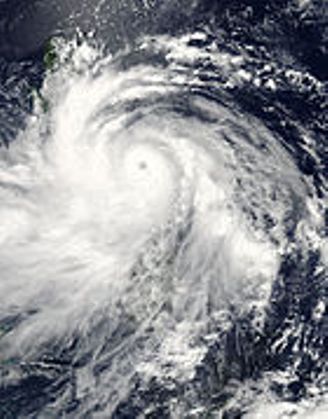Breaking
‘Glenda’ kills 10 in Philippines, shuts down Manila before heading for China

Typhoon Glenda (Rammasun) shortly before Philippine landfall on July 15. (NASA satellite image / Wikipedia photo)
MANILA – Typhoon Glenda (Rammasun), the strongest storm so far to hit the country this year , killed at least 10 people as it unleashed its fury across the Philippines on Wednesday, July 16, 2014.
The strong and swift typhoon brought the country’s business district to a grinding halt, shut down power throughout the island of Luzon, uprooted trees, and inflicted damage upon all in its path.
Rescue officials reported that over 370,000 were evacuated – mostly from the province of Albay – as a result of the typhoon; the eye of which passed south of Manila on Wednesday after churning through the main island of Luzon.
Many establishments – including government offices, schools, and financial markets – were closed for the day. Numerous schools will remain closed for tomorrow, as well.
Major roads throughout Luzon were obstructed by debris, such as tin roofs stripped off houses, and fallen trees and electricity poles.
In Batangas City, south of Manila, some people were trapped by fallen debris, while two others were electrocuted by toppled electric wires.
In Lucena City in Quezon province south of the capital, a 25-year-old woman was killed by a falling electricity pole, while a pregnant woman was killed when a house wall collapsed.
Storm surges in Manila Bay prompted disaster officials to evacuate urban slum-dwellers and informal settlers on the peripheries of the capital.
Richard Gordon, chairman of the Philippine National Red Cross, said that apart from uprooted trees and debris on the streets, there was minimal damage reported in the capital city.
“We have not received reports of major flooding in Metro Manila because the typhoon did not bring rain, but the winds were strong,” he said.
Tropical Storm Risk, which monitors cyclones, said that Glenda (Rammasun) is now a category-one storm, as it heads northwest into the South China Sea, with maximum sustained winds of 95 mph (153 kph).
However, the agency said that it is likely that the typhoon would increase in strength to a category-three storm in the next two days, as it gains energy from the warm seas towards the Chinese island of Hainan.
At least four southeastern provinces on the island of Luzon, among them, Albay and Camarines Sur, have either declared or are positioning to declare a state of calamity.
Meanwhile, some areas of Luzon remain without power.
Almost 400 flights were cancelled as airports in Manila shut down for four hours. Airport officials added that two airplanes received minor damage as strong gusts of wind slammed them into nearby obstacles.
Train services remain suspended due to lack of power, and are expected to resume operations tomorrow.





















